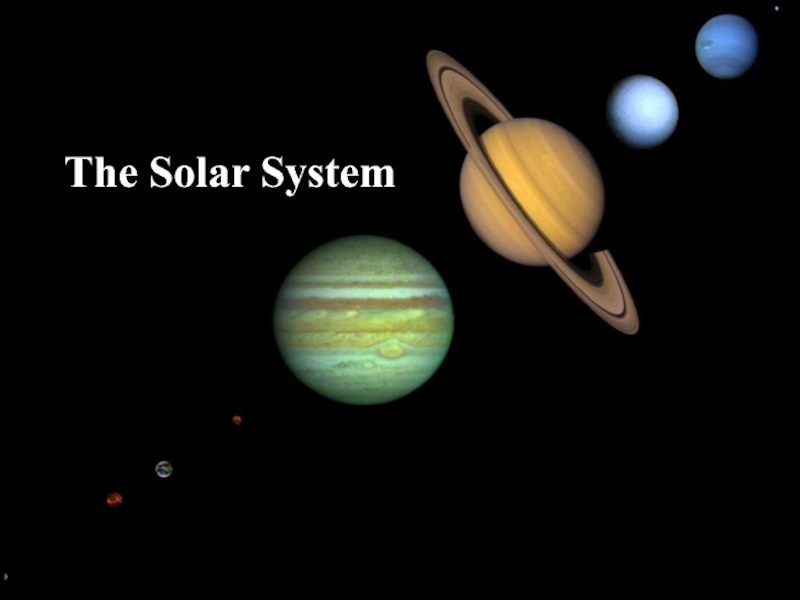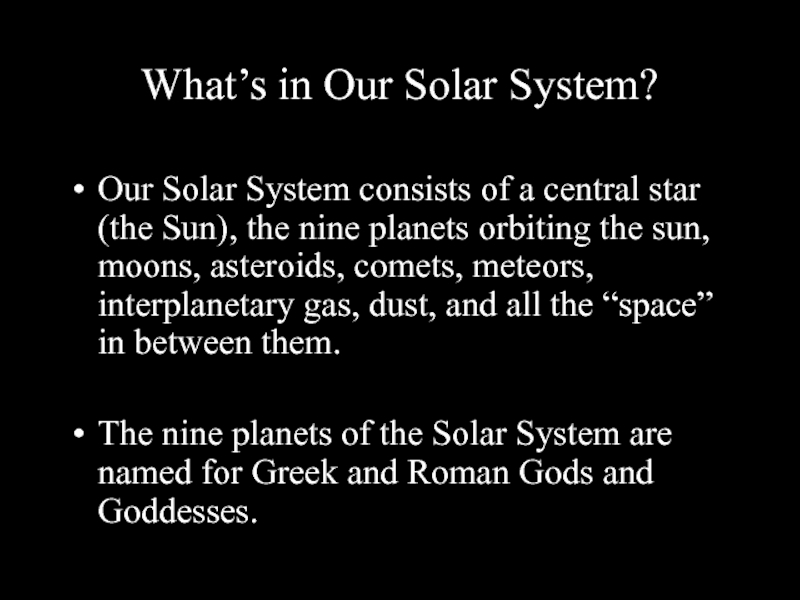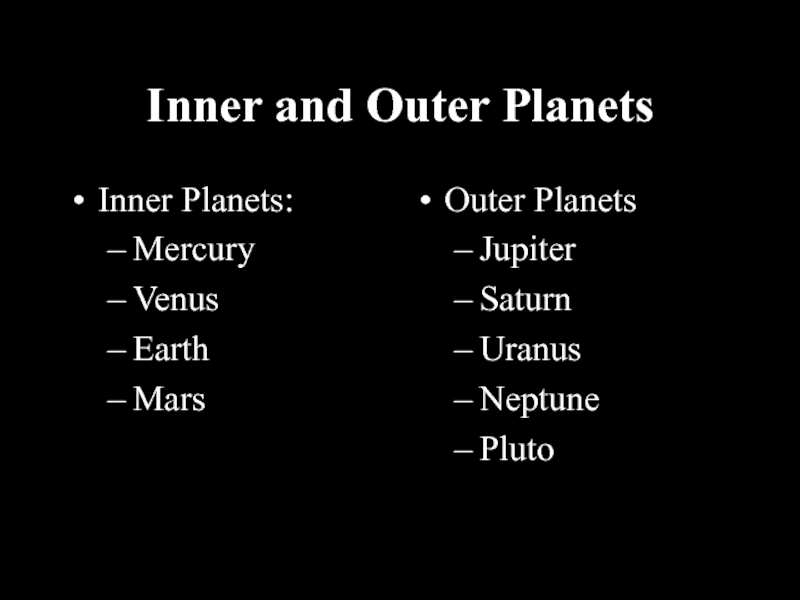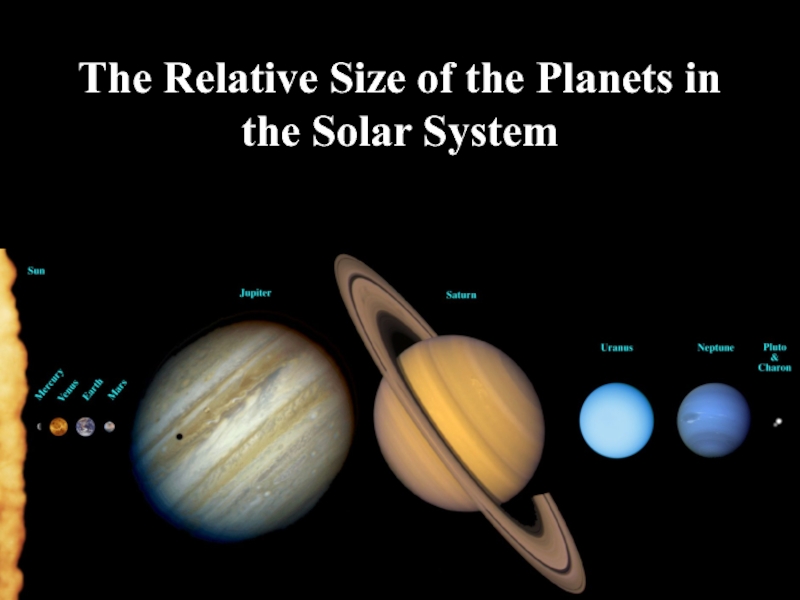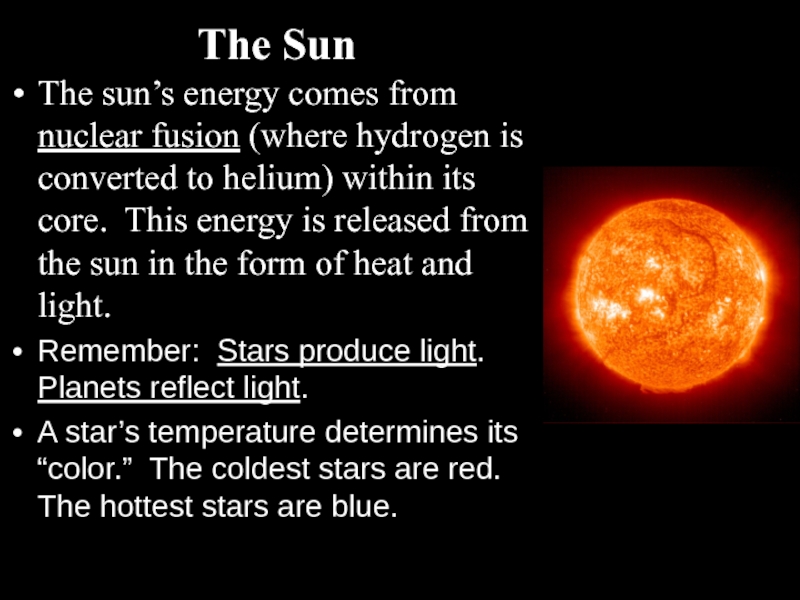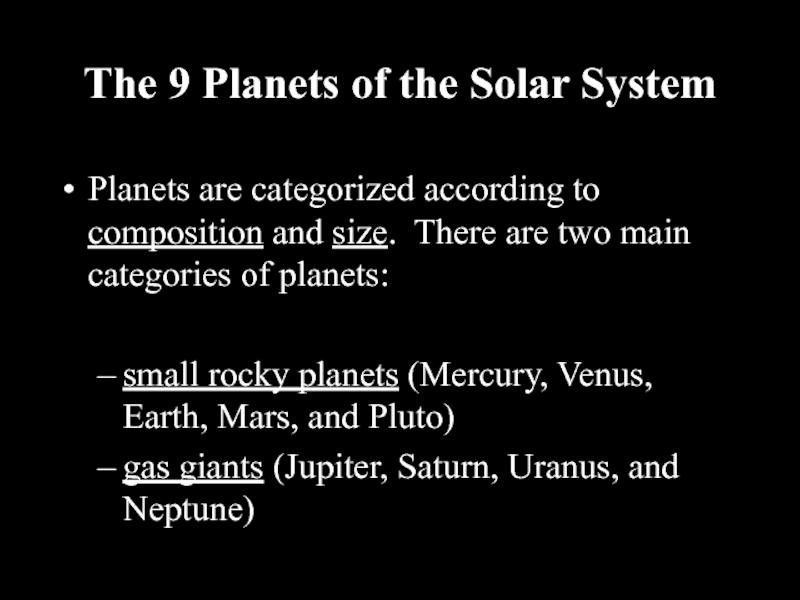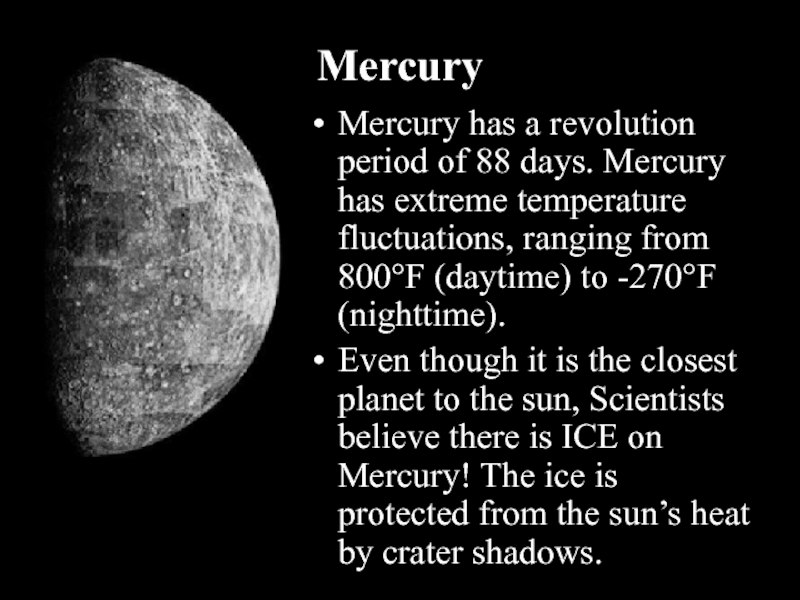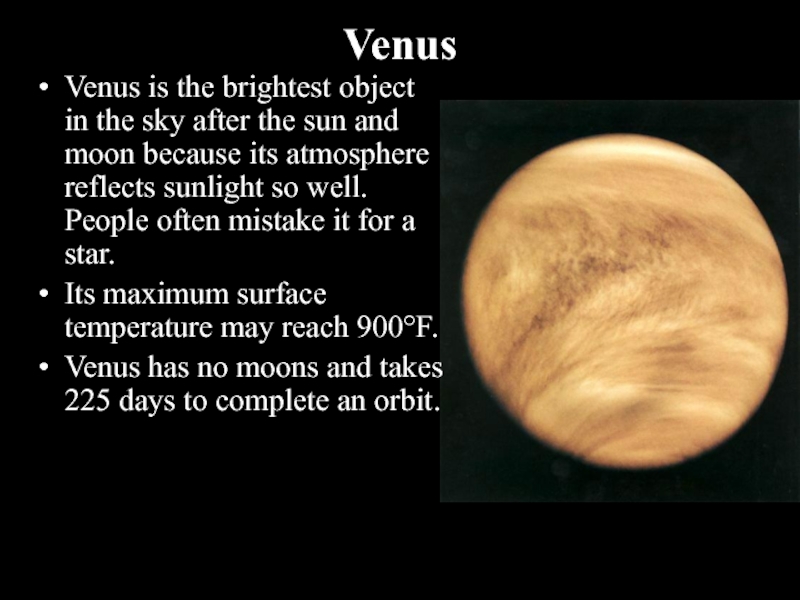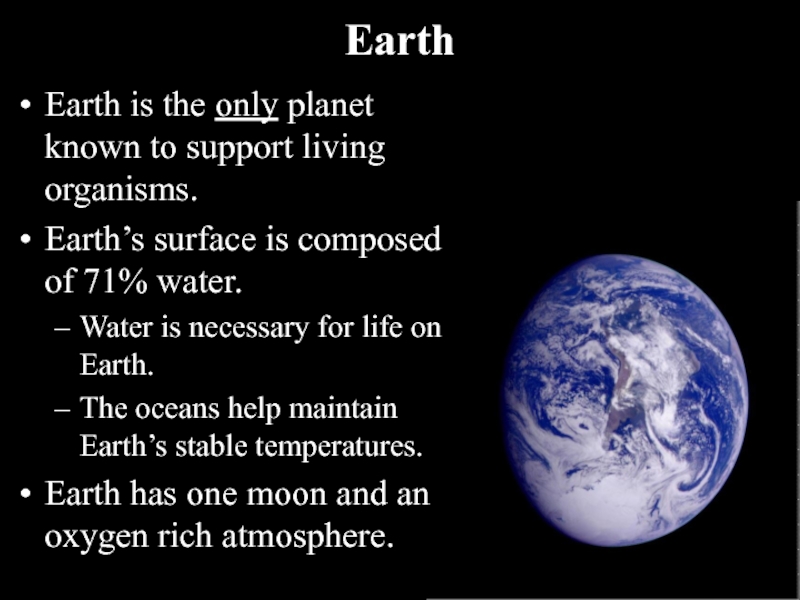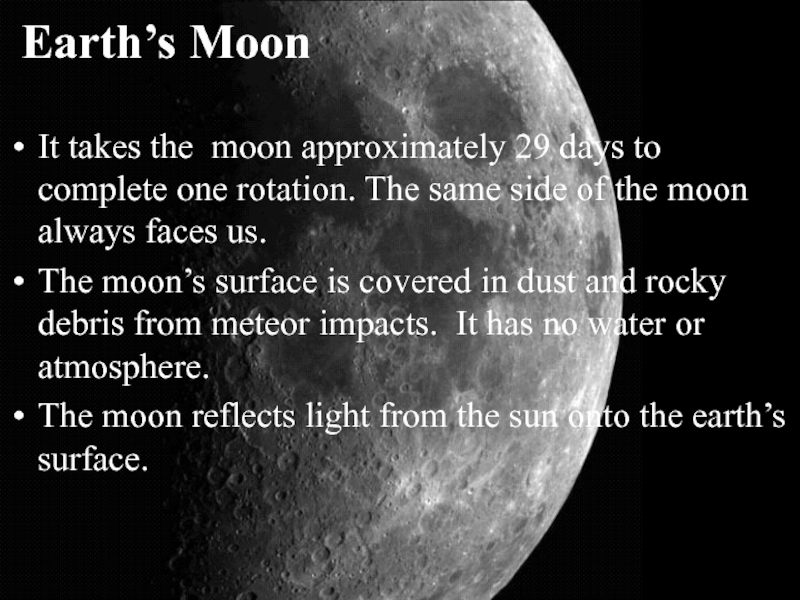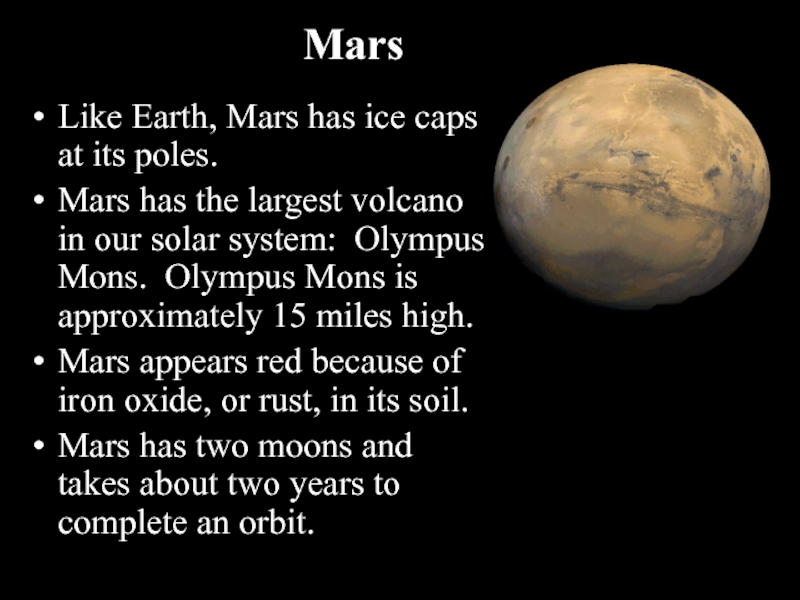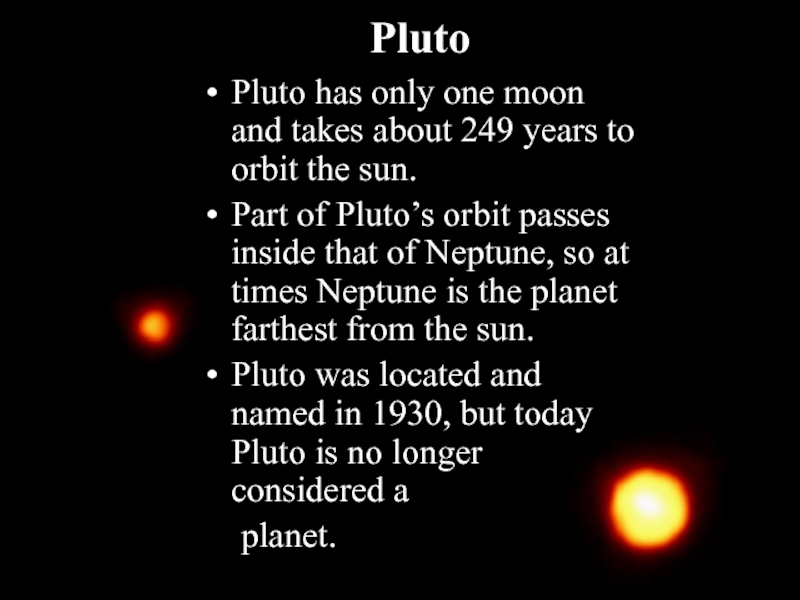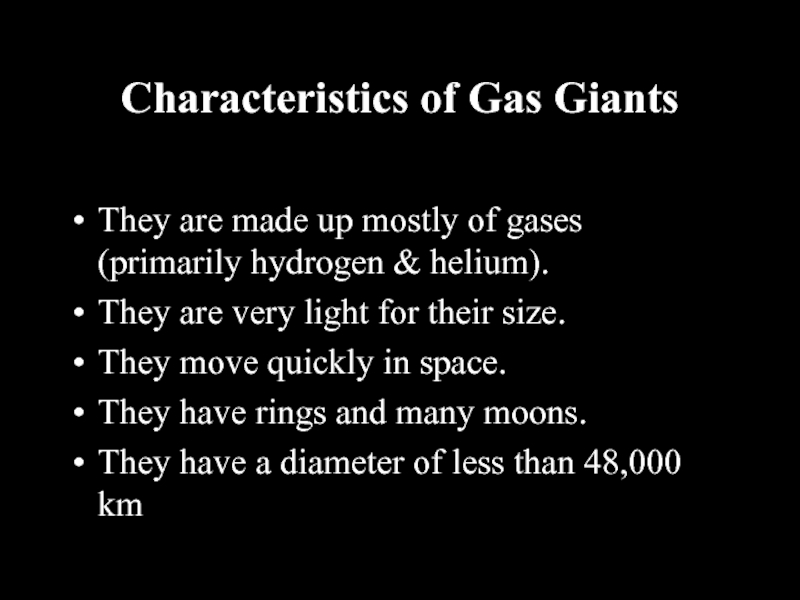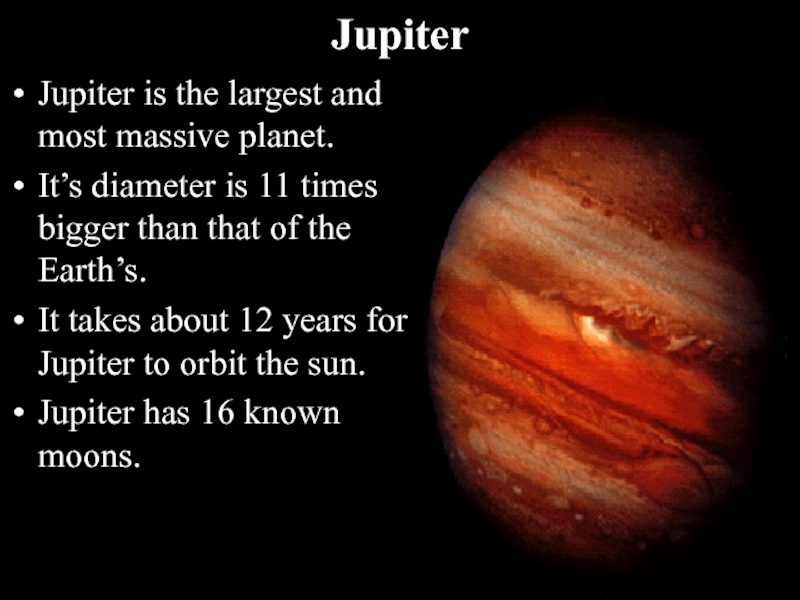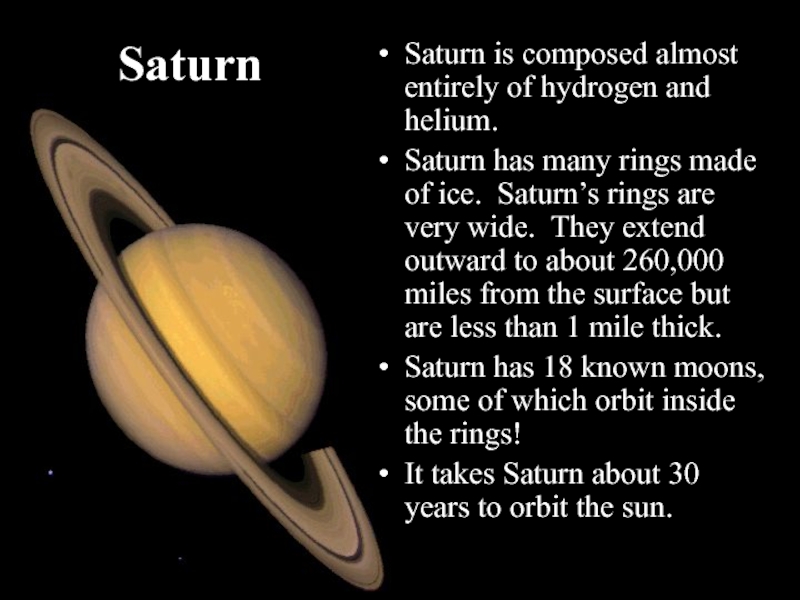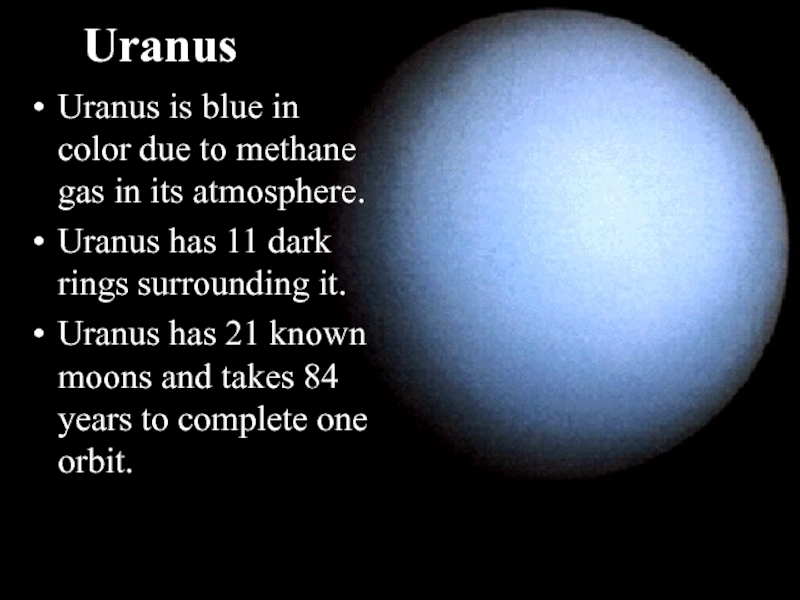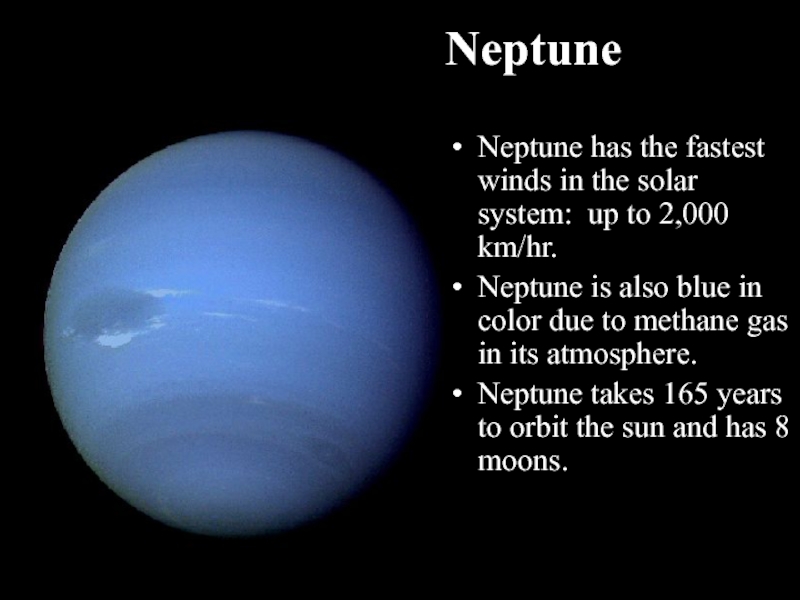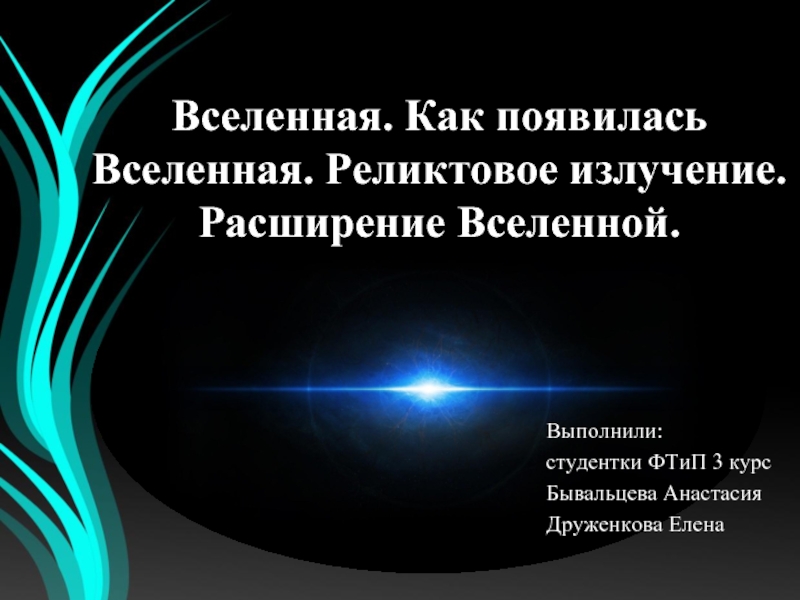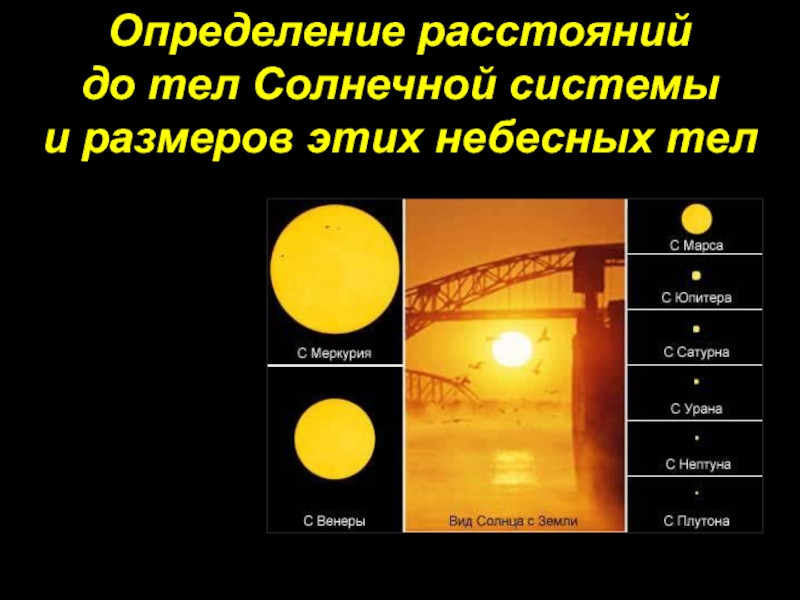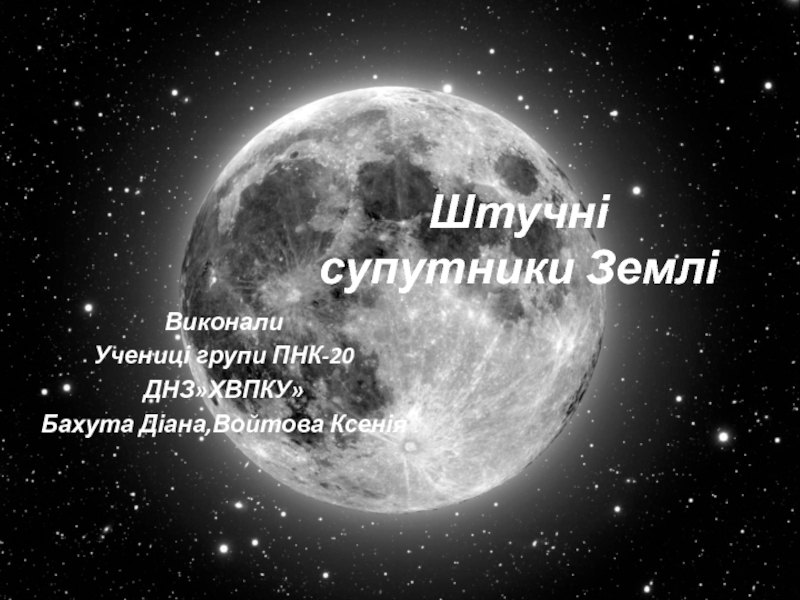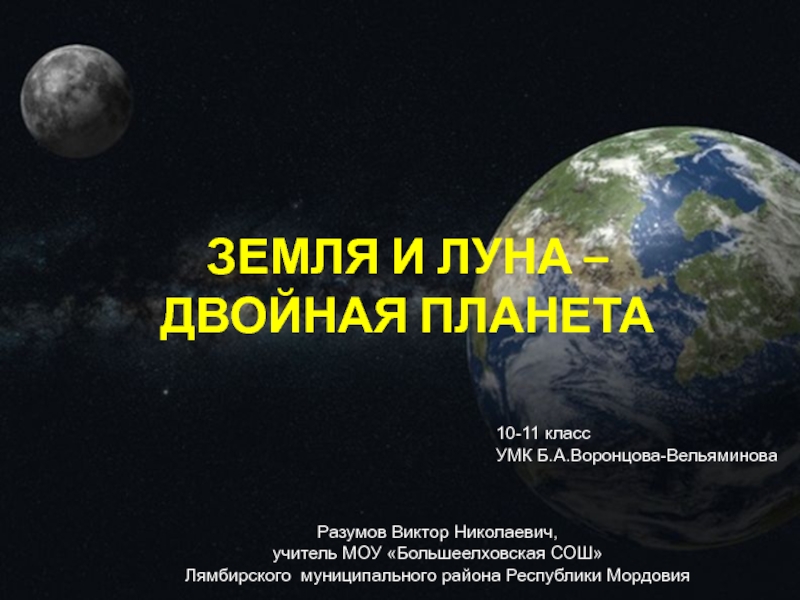- Главная
- Разное
- Дизайн
- Бизнес и предпринимательство
- Аналитика
- Образование
- Развлечения
- Красота и здоровье
- Финансы
- Государство
- Путешествия
- Спорт
- Недвижимость
- Армия
- Графика
- Культурология
- Еда и кулинария
- Лингвистика
- Английский язык
- Астрономия
- Алгебра
- Биология
- География
- Детские презентации
- Информатика
- История
- Литература
- Маркетинг
- Математика
- Медицина
- Менеджмент
- Музыка
- МХК
- Немецкий язык
- ОБЖ
- Обществознание
- Окружающий мир
- Педагогика
- Русский язык
- Технология
- Физика
- Философия
- Химия
- Шаблоны, картинки для презентаций
- Экология
- Экономика
- Юриспруденция
The Solar System презентация
Содержание
- 1. The Solar System
- 2. What’s in Our Solar System? Our Solar
- 3. Inner and Outer Planets Inner Planets: Mercury
- 5. The Relative Size of the Planets in the Solar System
- 6. The Sun The sun’s energy comes from
- 7. The 9 Planets of the Solar System
- 8. Characteristics of Small Rocky Planets They are
- 9. Mercury Mercury has a revolution period of
- 10. Venus Venus is the brightest object in
- 11. Earth Earth is the only planet known
- 12. Earth’s Moon It takes the moon approximately
- 13. Like Earth, Mars has ice caps at
- 14. Pluto Pluto has only one moon and
- 15. Characteristics of Gas Giants They are made
- 16. Jupiter Jupiter is the largest and most
- 17. Saturn Saturn is composed almost entirely of
- 18. Uranus Uranus is blue in color due
- 19. Neptune Neptune has the fastest winds in
Слайд 2What’s in Our Solar System?
Our Solar System consists of a central
star (the Sun), the nine planets orbiting the sun, moons, asteroids, comets, meteors, interplanetary gas, dust, and all the “space” in between them.
The nine planets of the Solar System are named for Greek and Roman Gods and Goddesses.
The nine planets of the Solar System are named for Greek and Roman Gods and Goddesses.
Слайд 3Inner and Outer Planets
Inner Planets:
Mercury
Venus
Earth
Mars
Outer Planets
Jupiter
Saturn
Uranus
Neptune
Pluto
Слайд 6The Sun
The sun’s energy comes from nuclear fusion (where hydrogen is
converted to helium) within its core. This energy is released from the sun in the form of heat and light.
Remember: Stars produce light. Planets reflect light.
A star’s temperature determines its “color.” The coldest stars are red. The hottest stars are blue.
Remember: Stars produce light. Planets reflect light.
A star’s temperature determines its “color.” The coldest stars are red. The hottest stars are blue.
Слайд 7The 9 Planets of the Solar System
Planets are categorized according to
composition and size. There are two main categories of planets:
small rocky planets (Mercury, Venus, Earth, Mars, and Pluto)
gas giants (Jupiter, Saturn, Uranus, and Neptune)
small rocky planets (Mercury, Venus, Earth, Mars, and Pluto)
gas giants (Jupiter, Saturn, Uranus, and Neptune)
Слайд 8Characteristics of Small Rocky Planets
They are made up mostly of rock
and metal.
They are very heavy.
They move slowly in space.
They have no rings and few moons (if any).
They have a diameter of less than 13,000 km.
They are very heavy.
They move slowly in space.
They have no rings and few moons (if any).
They have a diameter of less than 13,000 km.
Слайд 9Mercury
Mercury has a revolution period of 88 days. Mercury has extreme
temperature fluctuations, ranging from 800°F (daytime) to -270°F (nighttime).
Even though it is the closest planet to the sun, Scientists believe there is ICE on Mercury! The ice is protected from the sun’s heat by crater shadows.
Even though it is the closest planet to the sun, Scientists believe there is ICE on Mercury! The ice is protected from the sun’s heat by crater shadows.
Слайд 10Venus
Venus is the brightest object in the sky after the sun
and moon because its atmosphere reflects sunlight so well. People often mistake it for a star.
Its maximum surface temperature may reach 900°F.
Venus has no moons and takes 225 days to complete an orbit.
Its maximum surface temperature may reach 900°F.
Venus has no moons and takes 225 days to complete an orbit.
Слайд 11Earth
Earth is the only planet known to support living organisms.
Earth’s surface
is composed of 71% water.
Water is necessary for life on Earth.
The oceans help maintain Earth’s stable temperatures.
Earth has one moon and an oxygen rich atmosphere.
Water is necessary for life on Earth.
The oceans help maintain Earth’s stable temperatures.
Earth has one moon and an oxygen rich atmosphere.
Слайд 12Earth’s Moon
It takes the moon approximately 29 days to complete one
rotation. The same side of the moon always faces us.
The moon’s surface is covered in dust and rocky debris from meteor impacts. It has no water or atmosphere.
The moon reflects light from the sun onto the earth’s surface.
The moon’s surface is covered in dust and rocky debris from meteor impacts. It has no water or atmosphere.
The moon reflects light from the sun onto the earth’s surface.
Слайд 13Like Earth, Mars has ice caps at its poles.
Mars has
the largest volcano in our solar system: Olympus Mons. Olympus Mons is approximately 15 miles high.
Mars appears red because of iron oxide, or rust, in its soil.
Mars has two moons and takes about two years to complete an orbit.
Mars appears red because of iron oxide, or rust, in its soil.
Mars has two moons and takes about two years to complete an orbit.
Mars
Слайд 14Pluto
Pluto has only one moon and takes about 249 years to
orbit the sun.
Part of Pluto’s orbit passes inside that of Neptune, so at times Neptune is the planet farthest from the sun.
Pluto was located and named in 1930, but today Pluto is no longer considered a
planet.
Part of Pluto’s orbit passes inside that of Neptune, so at times Neptune is the planet farthest from the sun.
Pluto was located and named in 1930, but today Pluto is no longer considered a
planet.
Слайд 15Characteristics of Gas Giants
They are made up mostly of gases (primarily
hydrogen & helium).
They are very light for their size.
They move quickly in space.
They have rings and many moons.
They have a diameter of less than 48,000 km
They are very light for their size.
They move quickly in space.
They have rings and many moons.
They have a diameter of less than 48,000 km
Слайд 16Jupiter
Jupiter is the largest and most massive planet.
It’s diameter is
11 times bigger than that of the Earth’s.
It takes about 12 years for Jupiter to orbit the sun.
Jupiter has 16 known moons.
It takes about 12 years for Jupiter to orbit the sun.
Jupiter has 16 known moons.
Слайд 17Saturn
Saturn is composed almost entirely of hydrogen and helium.
Saturn has
many rings made of ice. Saturn’s rings are very wide. They extend outward to about 260,000 miles from the surface but are less than 1 mile thick.
Saturn has 18 known moons, some of which orbit inside the rings!
It takes Saturn about 30 years to orbit the sun.
Saturn has 18 known moons, some of which orbit inside the rings!
It takes Saturn about 30 years to orbit the sun.
Слайд 18Uranus
Uranus is blue in color due to methane gas in its
atmosphere.
Uranus has 11 dark rings surrounding it.
Uranus has 21 known moons and takes 84 years to complete one orbit.
Uranus has 11 dark rings surrounding it.
Uranus has 21 known moons and takes 84 years to complete one orbit.
Слайд 19Neptune
Neptune has the fastest winds in the solar system: up to
2,000 km/hr.
Neptune is also blue in color due to methane gas in its atmosphere.
Neptune takes 165 years to orbit the sun and has 8 moons.
Neptune is also blue in color due to methane gas in its atmosphere.
Neptune takes 165 years to orbit the sun and has 8 moons.
